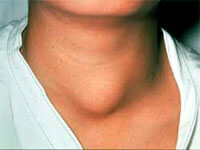Adrenogenital syndrome
 Adrenogenital syndrome is a complex of clinical and laboratory disorders caused by heritable defects in the production of corticosteroids against the background of a pronounced deficiency of the enzyme 21-hydroxylase. Signs adrenogenital syndrome can occur at almost any age with a predominant defeat of women's representatives.
Adrenogenital syndrome is a complex of clinical and laboratory disorders caused by heritable defects in the production of corticosteroids against the background of a pronounced deficiency of the enzyme 21-hydroxylase. Signs adrenogenital syndrome can occur at almost any age with a predominant defeat of women's representatives.
reasons adrenogenital syndrome
immediate etiopathogenetic factor occurrence adrenogenital syndrome is the lack of production of enzymes that have a reinforcing effect on the production process of hormonal substances by the adrenal cortex. In the body of a healthy person, the regulation of normal synthesis is provided by a genome located in one pair of the sixth autosome, and therefore, adrenogenital syndrome should be classified as a group of diseases with a recurrent type of inheritance. There is a group of patients with a hidden form of adrenogenital syndrome, so-called carriers who, in marriage to a person with signs of this pathology, can conceive a child with obvious signs of this deviation.
The basis of etiopathogenetic classification of adrenogenital syndrome is the character of the enzymatic defect. Thus, virilnoe its shape is accompanied by a partial deficiency of the enzyme 21-hydroxylase, while solteryayuschaya form is characterized by additional aqueous processes and disorders of mineral metabolism caused by a failure in the production of aldosterone and cortisol by the adrenal cortex.
In boys, signs of adrenogenital syndrome are extremely rare and are accompanied by minor clinical manifestations in the form of premature development of secondary phenotypic gender characteristics.
According to numerous scientific researches in the field of development of adrenogenital syndrome in different layers of the population, this pathology is more affected by persons of the European race.
Forms adrenogenital
syndrome In the world practice, endocrinologists used clinical classification adrenogenital syndrome whereby one main stands, or the classic form of the disease, and two non-classical forms with mild clinical picture. The formation of phenotypic signs of this rare pathology has a clear connection with the degree of deficiency of the enzyme 21-hydroxylase and concomitant hyperandrogenism.
Congenital adrenogenital syndrome, occurring in a classical form, is provoked by changes in the functioning of the adrenal glands during the period of their laying during fetal development. Due to the fact that the excess production of androgens has a direct effect on the formation of primary sexual characteristics, the full development of the internal organs of the small pelvis takes place in the female type, while the formation of the external genital organs is at the initial stage of development. Subsequently
excess testosterone impact provokes virilization only the external genitalia of the female fetuses, i.e. an increase genital tubercle, which is converted to the clitoris penisoobraznoy form, draining and forming folds labiosakralnyh psevdomoshonki, impaired separation urogenital sinus to the vagina and urethra. This type of virilization makes it difficult to determine the correct sex of a child after birth.
In addition to changes in the form and functioning of the genital organs, the child has hyperplasia of the adrenal glands, caused by excessive production of androgens from the beginning of the adrenal gland.
congenital adrenal hyperplasia in children, occurring in the classical form, is the rationale for the dynamic observation in pediatric endocrinologist, who determines the optimal age of the patient for surgical plastics malformations and further medical treatment to the child's development of female type.
In a situation where a birth defect of the enzyme 21-hydroxylase, had no impact on the functioning of the adrenal glands during fetal development, there is another critical period in the development of phenotypic traits adrenogenital syndrome - during pubertal development. In connection with this, this form of adrenogenital syndrome has the second name "pubertal".
The debut of the development of clinical symptoms occurs during the period of adrenarche, which occurs 3 years before the onset of menstruation and consists in the early development of secondary sexual characteristics, excessive hairiness and puberty "growth spurt".For this category of patients, a characteristic feature is the backlog of the period of onset of the first menstruation, which falls at the age of 16 years. In girls with adrenogenital syndrome, the period of normalization of the menstrual cycle takes a very long time.
Patients with a pubertal form of adrenogenital syndrome have characteristic phenotypic features that distinguish them from their peers( a fatty skin type with a tendency to acne follicular type, excessive stem hair follicles, high growth and broad shoulders, hypoplasia of the mammary glands).An experienced endocrinologist can establish a correct diagnosis after the initial examination of the patient.
In the event of excessive production of androgens after puberty, namely, after the age of twenty, the girls are concerned about the impossibility of conceiving a child and frequent episodes of spontaneous miscarriages at an early pregnancy. Difficulties of conception are explained by the irregularity of the menstrual cycle with a tendency to lengthen the intermenstrual period. A gross change in the phenotype in this pathology is not observed and the diagnosis can be established only after a comprehensive examination of the patient with the use of laboratory and instrumental techniques.
Diagnosis of adrenogenital syndrome
The presence of specific clinical manifestations in the patient, allows the endocrinologist or gynecologist to suspect the presence of adrenogenital syndrome after the initial examination, the final reliable conclusion can be established only after a laboratory examination. Hormonal diagnosis of adrenogenital syndrome is the gold standard for a long period of time.
Adrenogenital syndrome is characterized by a violation of the synthesis of corticosteroids in the phase of 17-SNP production, an increase in the level of this parameter in the blood is the diagnostic criterion of this endocrine pathology. Urine analysis with the determination of the saturation of 17-ketosteroids, which are metabolites of androgens, is of great importance in the diagnosis of adrenogenital syndrome.
In a difficult clinical situation, when there is a need for differential diagnosis between adrenogenital syndrome and other endocrinological pathologies accompanied by hyperandrogenism, it is necessary to perform a drug loading test with a glucocorticosteroid. In patients with classic adrenogenital syndrome, after this test, the level of steroids decreases by at least 70% in blood and urine.
Among the instrumental methods of visualization, ultrasound scanning of the pelvic organs with the maturity of the follicular apparatus of the ovaries is the most informative. Due to the fact that in most patients adrenogenital syndrome, anovulatory menstrual cycle is observed, with an echoscopy there is a slight increase in the parameters of the ovaries with the presence of a large number of immature follicles.
Treatment of adrenogenital syndrome
Laboratory and instrumental confirmation of diagnosis is the rationale for conducting adequate hormone replacement therapy with glucocorticosteroid drugs.
The appointment of any glucocorticosteroid must be strictly dosed and controlled by laboratory indicators of blood and urine. The use of Dexamethasone in a daily dose of 0.25 mg should be performed until the moment of elimination of the main clinical manifestations of the disease( normalization of cyclic basal temperature, removal of dysmenorrhea, echoscopically confirmed elimination of ovarian multifollicularity).Absolute criterion of the positive effectiveness of hormone therapy in this case is the onset of a planned pregnancy, but this fact is not an indication for interrupting the drug intake. Dexamethasone during pregnancy is advisable to apply until the formation of the placenta, which ensures the normalization of the hormonal status of the fetus.
Women who have a period of pregnancy coincided with the intake of hormonal glucocorticoid drugs, are to be hospitalized in order to conduct a dynamic ultrasound study, as well as determine the concentration of 17-ketosteroids in the urine. The presence of a pregnant woman who takes hormonal therapy to treat adrenogenital syndrome, spontaneous abortions in a history is the rationale for the appointment of estrogen-containing hormones, the action of which is aimed at improving the intake of oxygenated blood to the developing fetus. Among the broad spectrum of this group of medicines, the most widespread was Microfolline, whose efficacy is maximal at a therapeutic dose of 0.25 mg per day. The appearance of a woman's bloody discharge or drawing pains in the lower abdomen is an indication for the withdrawal of the drug.
Due to the fact that women suffering from adrenogenital syndrome have problems with fetal bearing and a tendency to spontaneous miscarriage at an early pregnancy, it is advisable in this situation to prescribe a natural progesterone analogue "Dufaston" in a daily dose of 20 mg. Long-term use of this drug eliminates isthmicocervical insufficiency, which is the most common cause of spontaneous abortion.
A drug that has a stimulating effect on the development of ovulation is Clomifene, the use of which is recommended to be combined with glucocorticoid therapy. Patients must always comply with the regimen of taking the drug, which consists of taking it in a daily dose of 100 mg from the third to the seventh day of the menstrual cycle every month until the onset of pregnancy.
In a situation where signs of adrenogenital syndrome have debuted at adulthood, when a woman is not interested in maintaining reproductive function, therapy is recommended with combined preparations containing antiandrogens and estrogens( Androcour at a dosage of 25 mg).It should be borne in mind that this group of drugs is classified as symptomatic, eliminating minor phenotypic manifestations of the disease, and with the withdrawal of the drug, the reverse development of the disease is possible.
To combat hyperhisitism, hormone therapy is not applied and in this situation, endocrinologists resort to the appointment of Veroshpiron in a daily dose of 100 mg in the morning, long-term use of which significantly reduces the manifestations of excess hair.
The area of application of hormonal contraceptive preparations containing a low-dose gestagenic component devoid of androgenic influence is a group of patients with signs of late post-pubertal form of adrenogenital syndrome. Before using this group of drugs, you should make sure the patient's unwillingness to maintain the reproductive function, since these hormones with long-term administration provoke the development of amenorrhoea hypogonadotropic type.



